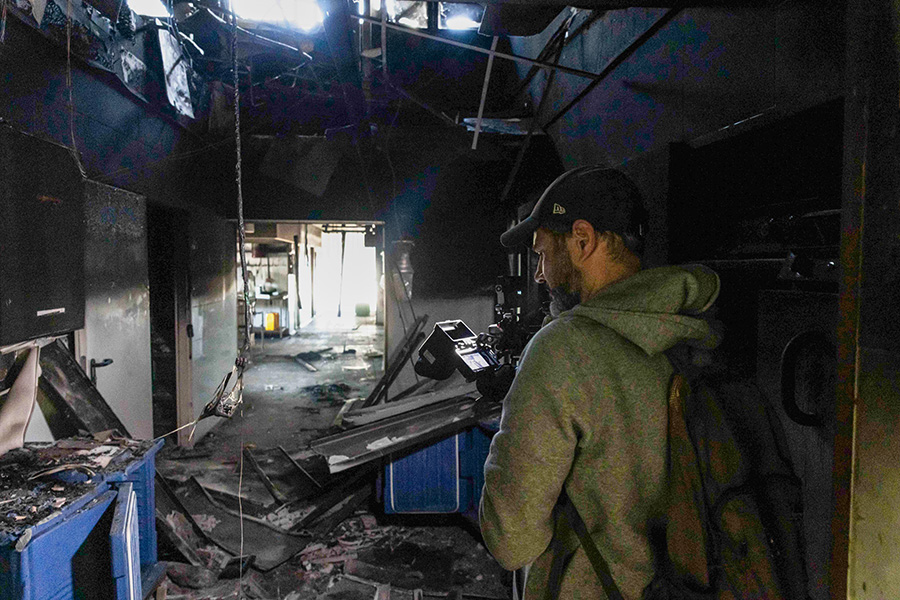
"Soon there will be nothing left here. Everything will be torn down, and new houses and neighborhoods will be built. The plans have already been drafted – everyone wants to begin to rebuild," said David Zell, a member of the Israel Antiquities Authority (IAA) and the animating force behind a project to document and preserve the buildings that were destroyed in Israeli communities along the border with the Gaza Strip on October 7.
Zell is an expert in photogrammetry, a technique for advanced documentation of ancient buildings using imaging technologies based on digital photography. He and other experts in the field were recruited by the IDF Spokesman's Unit in the first days of the war and sent to document the destruction in the region, known in Israel as the Gaza Envelope.
Zell, who is responsible for documentation on behalf of the IAA, recruited his friends to the mission, which became a national project led and financed by the Ministry of Heritage and the Tekuma Authority for the rebuilding of communities in the Gaza Envelope.
"The state aims to clean up the area as quickly as possible and return the residents to their homes and restore the surrounding area," he said, clarifying the urgency of his mission. "The more we document, the more the future generation will have an understanding of what happened here."
He cites as an example the demolition this week of a house on Kibbutz Be’eri that was the site of a hostage crisis on October 7, with 40 terrorists holding 14 kibbutz members and their guests hostage. In the midst of a battle with the IDF, a tank fired at the home, killing all but two hostages who survived to tell the tale.
"But they didn't destroy the building until after we had gone in and documented it," Zell emphasized.
A Walker, Pieces of a Piano: Evidence of a Life Cut Short
This week, the IAA's documentation team worked at Kibbutz Nir Oz, which suffered the worst damage in the Hamas attack. 105 of its approximately 400 residents were murdered, kidnapped, or are still in captivity.

The paths in the evacuated kibbutz, some of whose residents have moved to temporary residences in Kiryat Gat, are crowded these days with visitors. A team from the Spielberg Foundation films testimonies; a group of foreign journalists stands at the entrance to the dining hall, next to the door riddled by Hamas bullets, on their way inside to hear testimonies from the survivors of the massacre; another group of foreign visitors sits with Daniel Lifshitz, grandson of Yocheved, who was released from captivity, and Oded, who is still a prisoner in Gaza.
The sights are difficult. At the western end of the kibbutz stands the remains of the home of 80-year-old Amitai Ben Zvi, who lived there with his Filipino caregiver, Jimmy Pacheco. The house is burnt. All that remains is the safe room, where Ben Zvi was found shot dead in his bed. Pacheco was kidnapped to Gaza and released. In the middle of what used to be a living room, Ben Zvi's walker, medicine boxes labeled with his name, and his grandchildren's toys are scattered, the last evidence of a life that was cut short.
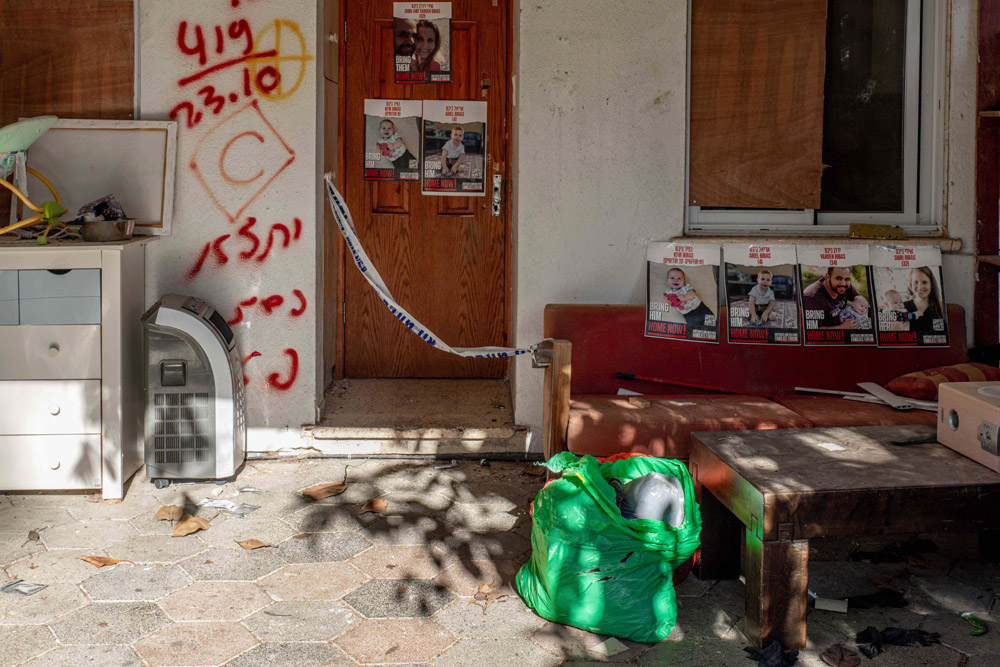
The next house belongs to Ofer Calderon, who was abducted and taken to Gaza with his children. The children were released while he remains in captivity. A few houses away is the Bibas family home. The yard remains exactly as it was on October 7, with the children’s strollers and games in the garden. Pictures of Shiri, Yarden and their redheaded toddlers Ariel and Kfir are hung on the door. The entire family is still in captivity.
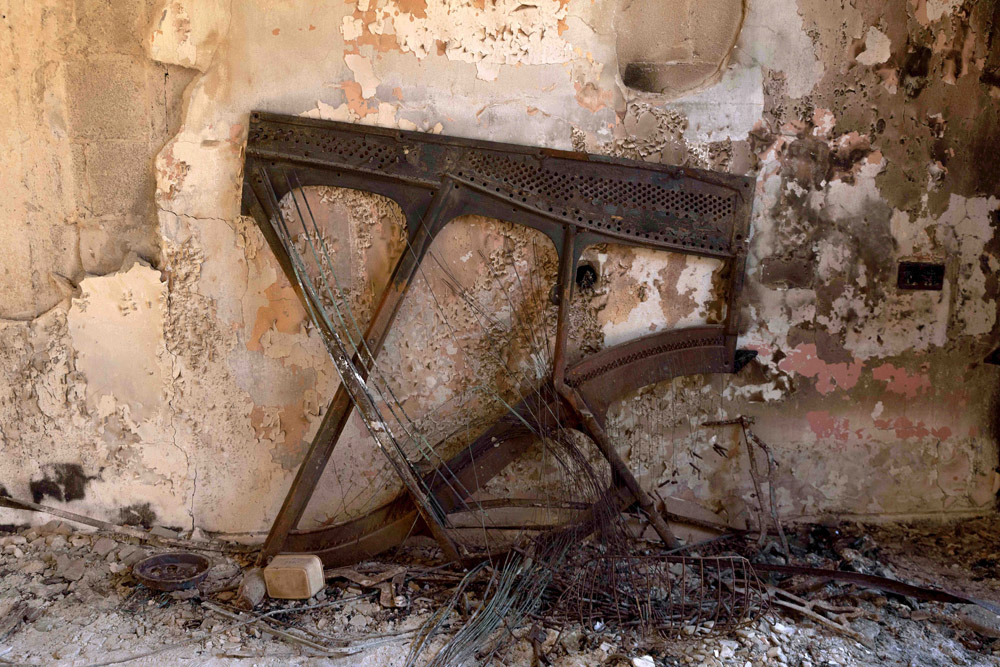
The next house is the home of Yocheved and Oded Lifshitz, which is completely burnt down. The smell still hangs in the air. Remnants of the piano that Oded played lie in the living room next to a burned-out television set. The same sights are repeated in house after house at the small, quiet kibbutz, whose residents have, against their will, become heroes of the ongoing war.
A Released Hostage Looks After the Cats
The grass of the kibbutz remains green, despite it all. Yelena Trupanov, 50, who was abducted to Gaza and released after 54 days, treads on it quietly. Only after her release did she find out that her son Sasha, her mother and her husband had also been kidnapped. Her mother was released with her, her husband was murdered in captivity, and her son is still a hostage. Since her release, Trupanov has been living in the Kfar Maccabiah hotel in Ramat Gan, returning to the kibbutz twice a week to feed the cats.
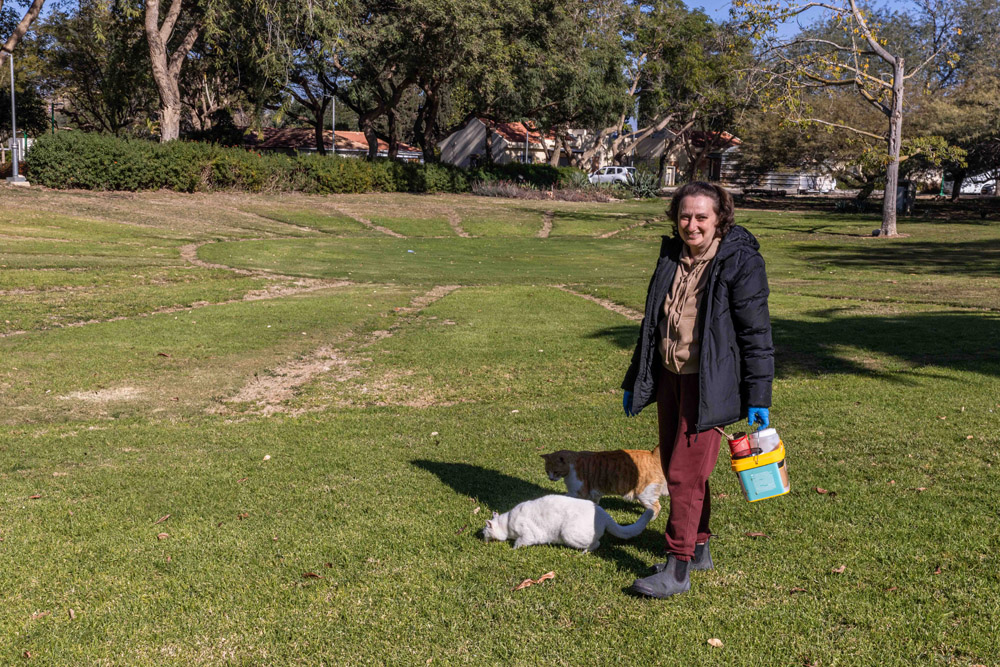
"A few days ago, they said that we should evacuate Kfar Maccabiah," she said. "I told them no problem, I will go back to live in my burnt house in Nir Oz."
There is almost nothing left of the house. All of her and her husband's belongings, including their clothes, were burned.
"I'm fine, but I'm very worried about Sasha, and I'm constantly moving from place to place to fight for his release," Trupanov continued. “When I have time, I come back here to take care of the cats."
The Remains of the Tut Kindergarten
Moving between the destroyed houses with the IAA team, it is easy to see what Zell means when he describes their project as "freezing October 7." At the entrance to the Tut Kindergarten, there are only three hats left on the rack, a display of clay pomegranates made by the children, and a bulletin board decorated with shofars and pomegranates for the Jewish holiday of Yom Kippur. Holiday cards that the kindergarteners wrote to each other still hang from the board, along with the words "gmar chatima tova," a traditional Yom Kippur greeting that loosely translates to "may you be inscribed in the book of life."
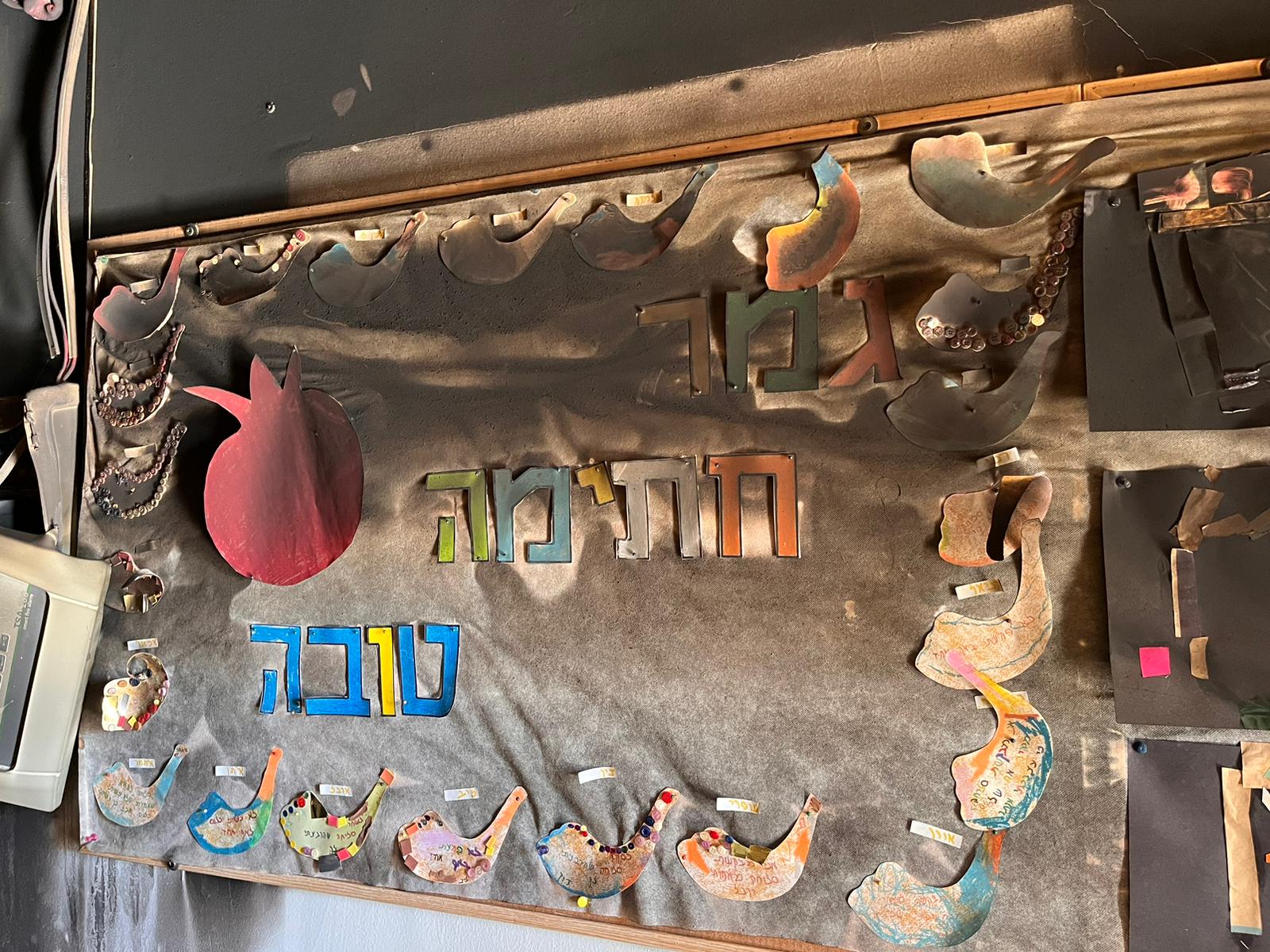
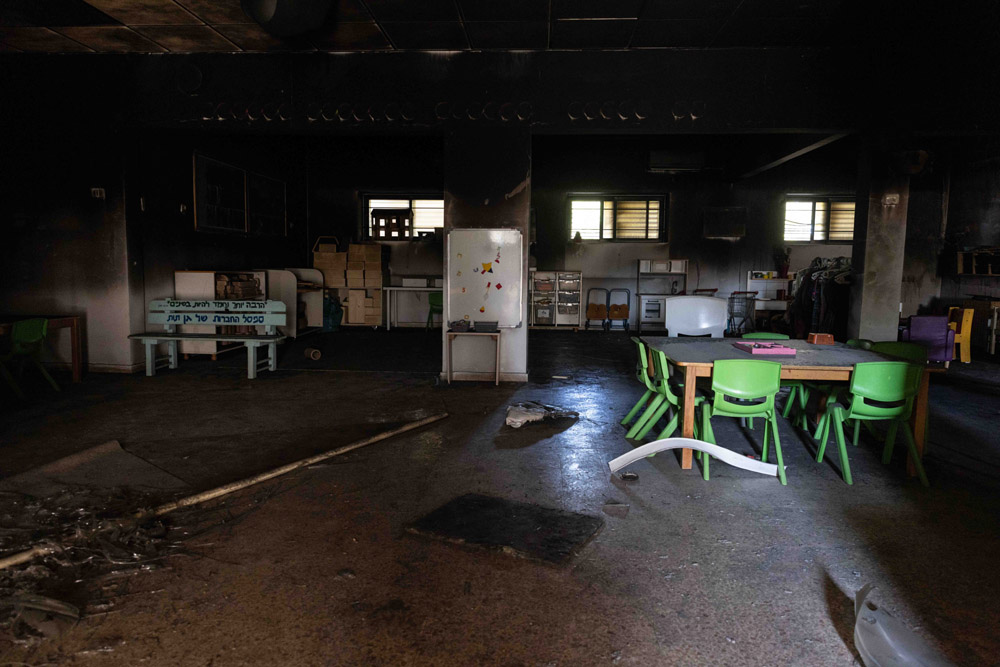
The small chairs are arranged around the low tables, on which the art supplies are placed. Everything is ready for the school day that was supposed to begin on the morning of Sunday, October 8. On the side of the sooty room stands the "Friendship Bench," a project initiated by Shani Avigal, the mother of 5-year-old Ido, who was killed in 2021 by a shard of a rocket fired through the window of his safe room in Sderot during Operation Guardian of the Walls.
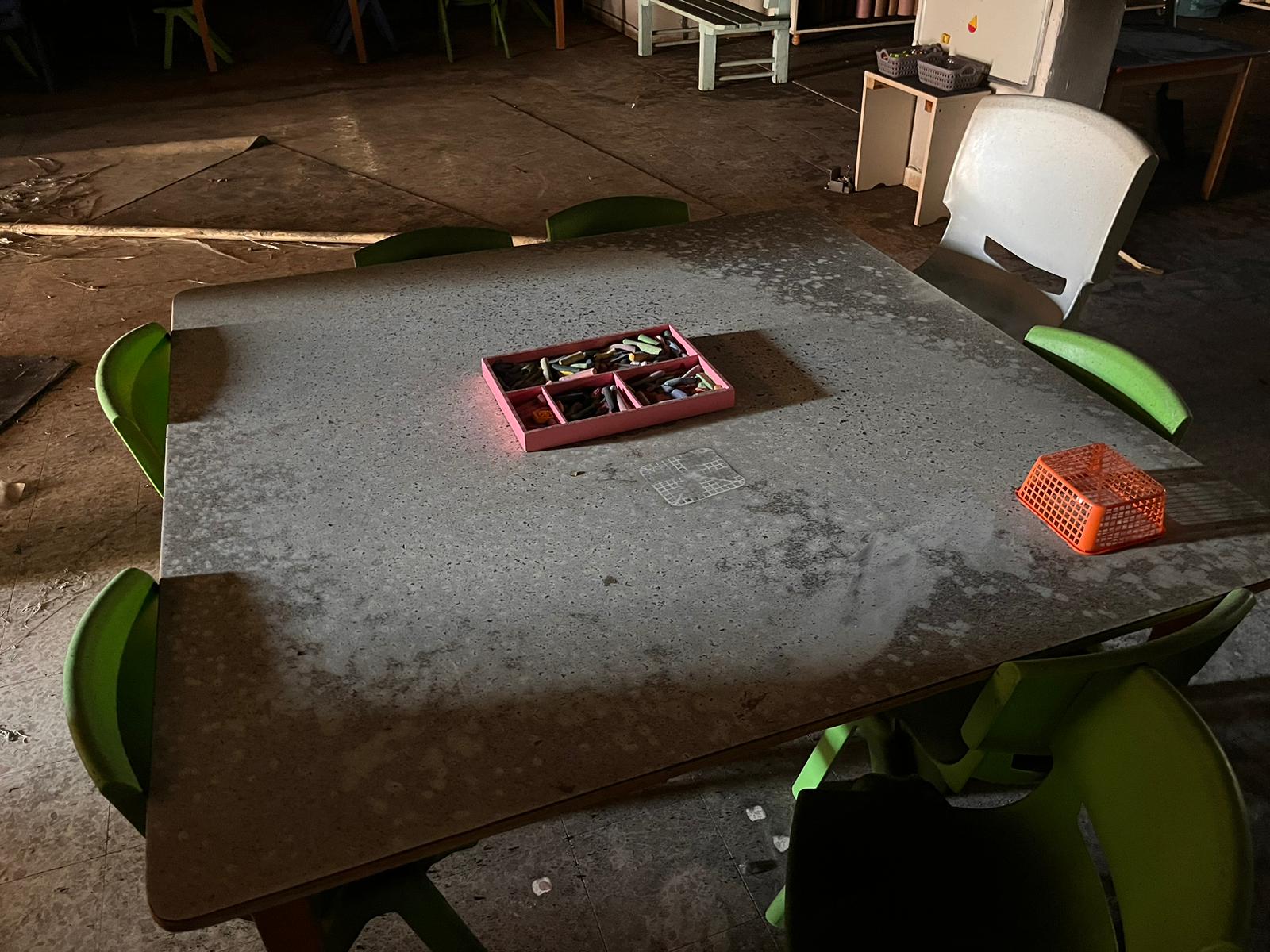
The children are gone, but the smell of fire lingers in the air. The kindergarten is set to be demolished.
"That's why our project is important," Zell explained. "We photograph a situation, document it down to the millimeter, so that in the near and distant future, we will be able to explain what happened here. [We will] turn the documentation and photos into a film, or a life-size model that we can actually walk around in."
The 3D documentation of the kindergarten will not replace the life that existed here. Even if they build a museum and present an exact reconstruction of the building, it will not be the same. But it’s the closest thing there is.
Still Photos on 3D Models
The documentation process using 3D models begins with photographing and measuring the site in high resolution. After that, a model will be built on a powerful computer on which digital images will be superimposed. The method has an important scientific aspect: objectivity and fidelity to the source. The process is done on the basis of points of reference without significant intervention of the documenter.
"In preparation for the court hearing in the Hague, they contacted us and asked for some of the materials," said Ami Shahar, head of preservation at the IAA. "In general, I am contacted by every possible authority – the police, the army, security services. Everyone wants, and rightfully so, to use the materials we collect here."
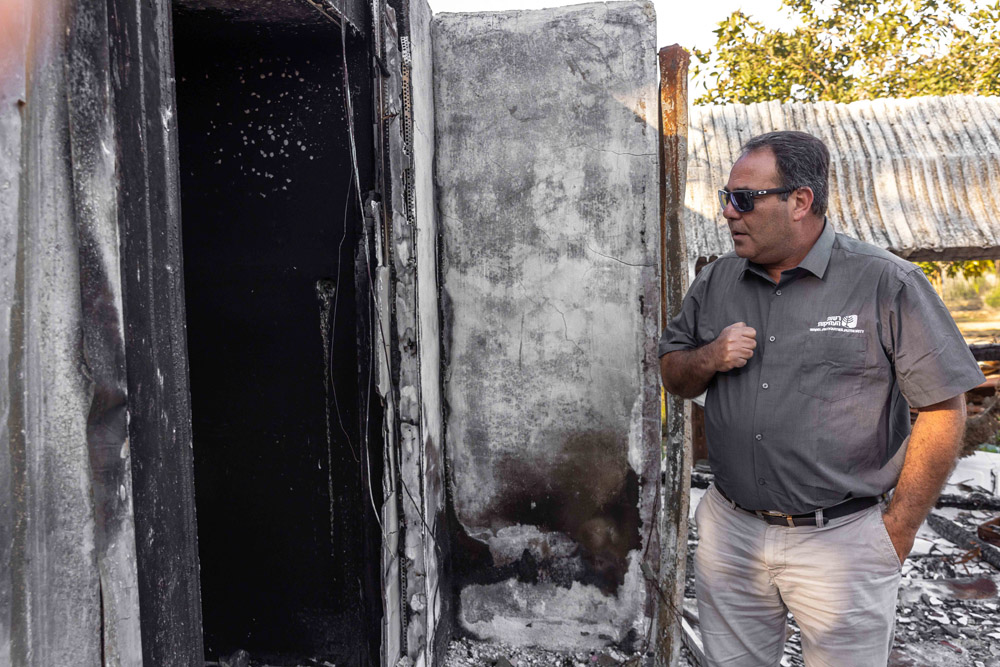
The team doesn't just document damaged houses. In the last two months, the site of the Nova music festival was also documented, including many of the vehicles that were damaged there, as well as the bomb shelter where Aner Shapira was hit and killed by a grenade after tossing back grenades thrown in by terrorists. The shelter's documentation was converted into a video that was passed on to Shapira's family.
Drones, Laser Scanners, Wide-Lens Cameras
Three types of devices are required for documentation: a huge drone that scans the area from a height of about 50 meters (164 feet) and smaller drones that fly around the houses or inside them.
The second device is a high-quality and expensive laser scanner, which “costs tens of thousands of dollars and is accurate to the millimeter,” according to Zell. And the third are digital cameras with wide lenses, with which expert photographers take several thousand photos inside the buildings.
The plan is to scan all of the houses in all of the communities in the Gaza Envelope.
"It was important for us to start with the communities that were most severely affected, in order to document the many dimensions of the destruction, and then move to buildings in other places," Zell said. "I estimate that we will be able to document most of the communities."
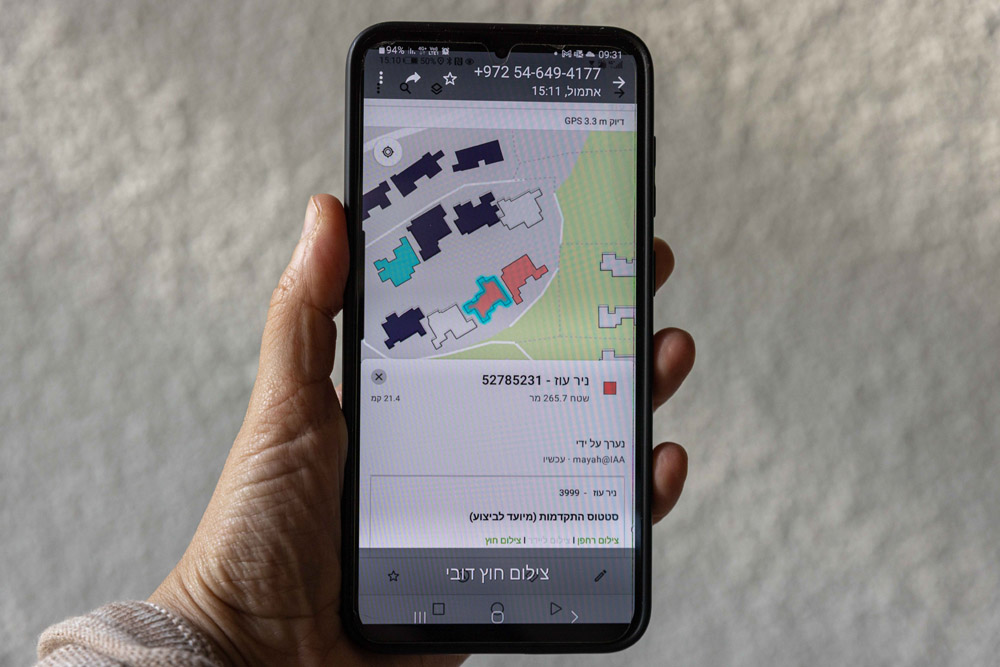
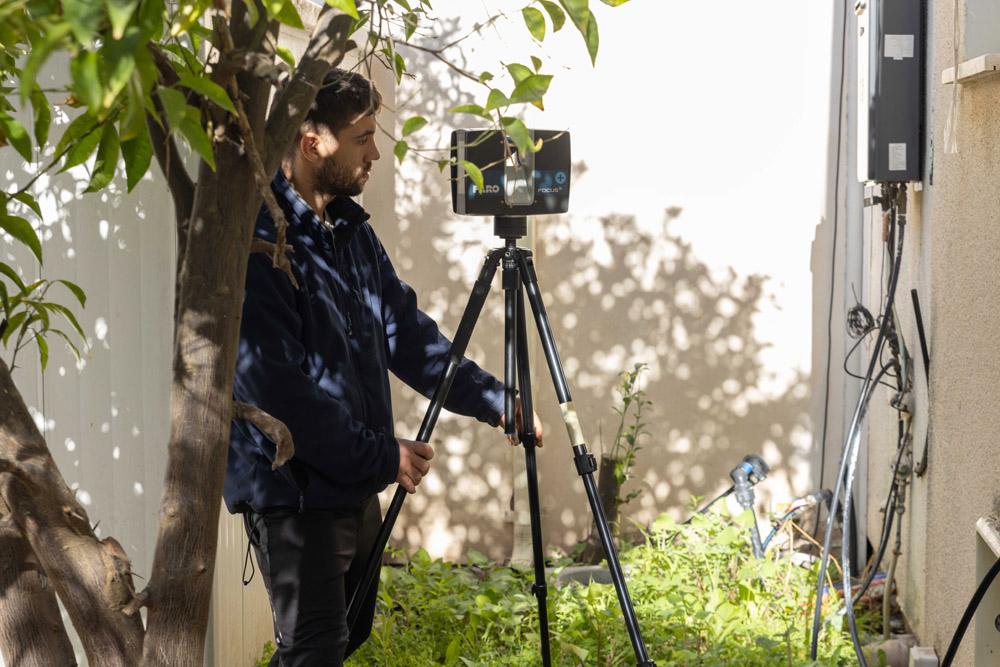
The pace of work is dictated by the limited number of people and equipment.
"If I could have mobilized more equipment and more people, of course we could have finished sooner," Shahar said, explaining that the processing of the material also requires extensive time and resources, including "special computers from the United States that can take in a huge amount of information and process it accurately."
The processing work started in a tiny room, he says, "and today we already have a huge office in Jerusalem." It is still not clear what they will be able to do with the large amount of material collected.
"There is also the issue of copyright. Who does the material actually belong to? To the state, to the citizens whose houses these are, to the communities?" Shahar continued. "It's a very sensitive issue, and there are delicate mechanisms that handle it. For now, the material is confidential."
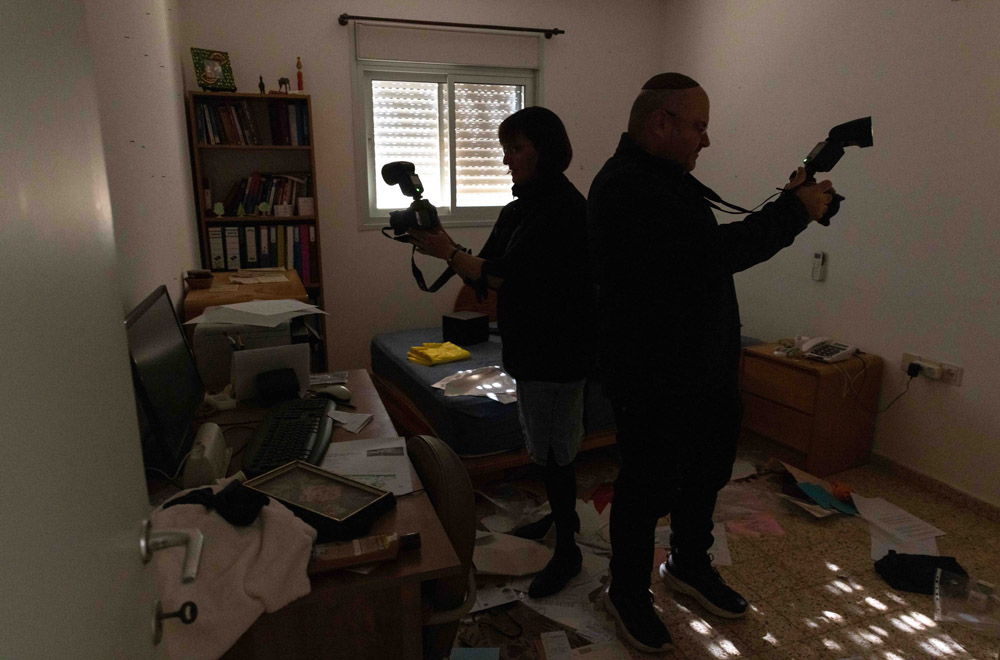
The collected materials will be able to be used for various purposes.
"For example, in the trials of Hamas terrorists, with the help of the digital location, it will be possible to match the evidence with the findings in the field,” Shahar explained. "I am a lawyer by profession and I know that in order to convict a person in Israel, you must have proof of the actions. I believe that our documentation will play a critical role.
"After the entire area is digitally mapped, it will be possible to add the photos of Hamas members, or, in contrast, of the survivors," Zell added. “Since the digital photos have a location in real time, it will be possible to 'paste' them onto the models we produce."
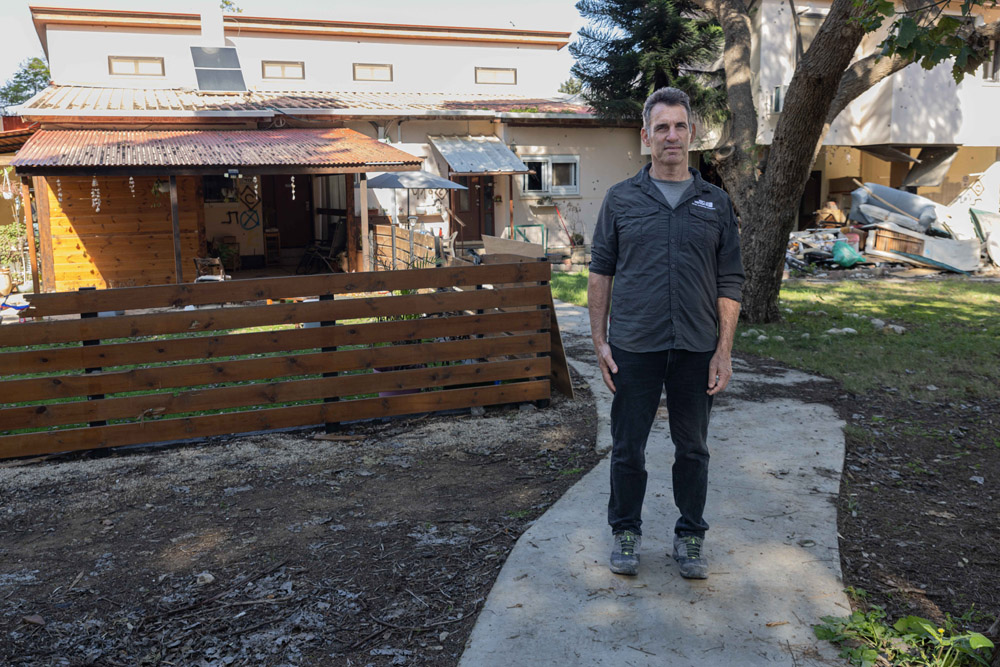
The documentation will also provide an understanding of how the attack unfolded – the strategy and tactics of Hamas fighters in their raids of the communities.
"The project started at the level of the individual buildings, the houses that burned down or where specific people were murdered. But you combine documentation from one house with that of the house next to it, and a complete picture of the scene of the fighting emerges," Zell said. "When I started attaching the models to each other, I also began to understand the picture of the battle. Because we documented things exactly as they were, you can see exactly which direction the terrorists came from.
"For example, in Kibbutz Be’eri, [Hamas] had a method: they sent the first squads that breached the kibbutz fence from several places and hid in observation posts from which they launched RPG missiles. Then fighters entered and began raiding the houses, murdering the residents and burning the houses. In the model you see the methodical way in which they operated," he continued.
In Nir Oz, he identified a different method of operation: there was no battle between Hamas and IDF forces and no additional damage to other houses.
"There were also many hostages here, compared to other localities,” Zell said. “You can see that [Hamas] had complete control over the kibbutz and they could move relatively quietly; they kidnapped residents and burned several houses."
"My Soul Couldn’t Take Any More"
Alex Efron, one of the most veteran documentarians in the project, has been involved almost from the very beginning. He has already documented close to 40 homes in various kibbutzim in the Gaza Envelope, and is currently responsible for the documentation in Kibbutz Kissufim.
"I just came back from a two-week vacation," he said. "They needed me to manage an excavation site in my district, in the north, so I left here. I had to do it also because my soul couldn't take any more."
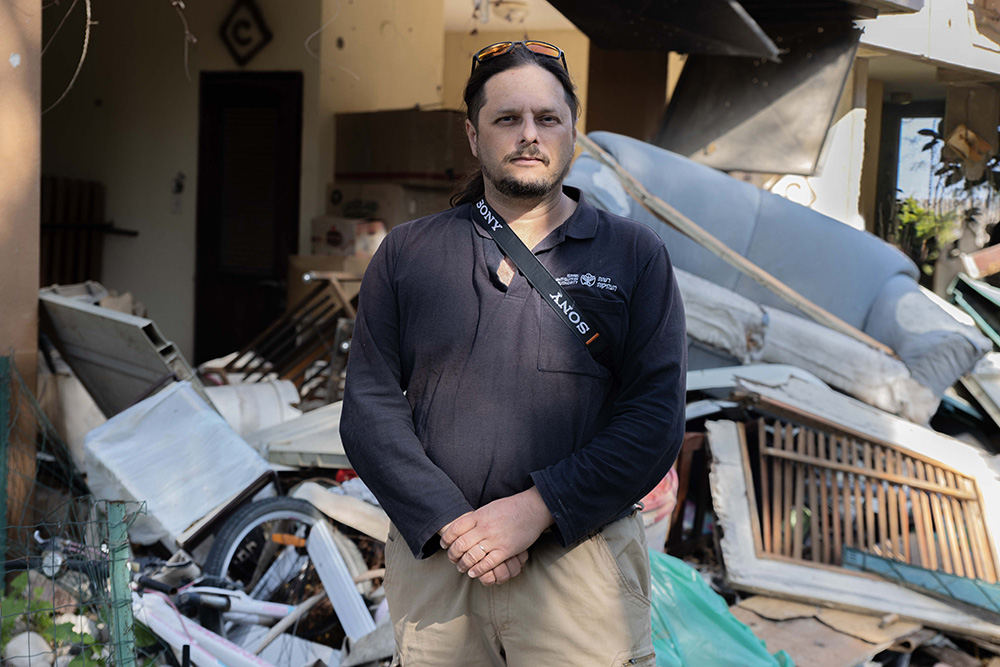
Efron is committed to the project. He leaves home on Sunday, leaving his wife and children, and returns home at the end of the week.
"It's very difficult," he said. "I've already learned how to detach myself from the scenes I'm photographing, to deal with the camera, its direction, the technical side. But I'm a father of children, and when you photograph a little girl's bed, a doll, a game, or a wardrobe, these are scenes that don't leave your mind."
Efron explained that some documentarians joined the project and left within a few days because of the emotional intensity.
"There’s a secret method that we Russians use to deal with problems, but I’d rather not go into detail," he said. "I think that if they take this documentation and use it to build a museum, I would choose not to visit it, or maybe only once. One visit to Yad Vashem and the Ghetto Fighters’ Museum was enough for me."
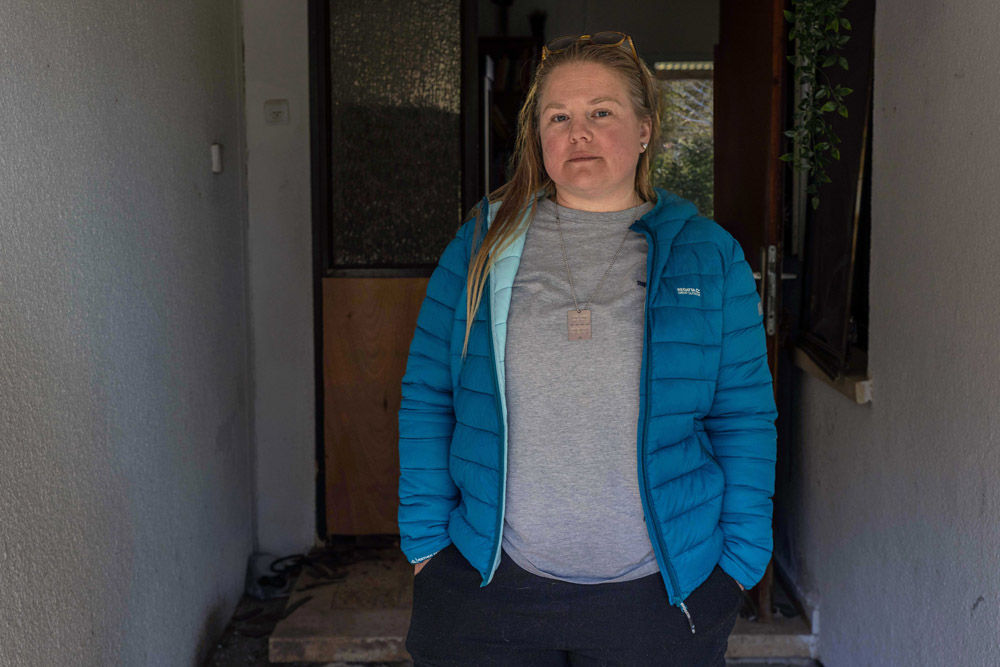
Each of the documentarians reacts differently. Anna Haltov, an archaeologist at the IAA, uses a different defense mechanism.
"It's not that it doesn't speak to me, or that I'm not sensitive; I just mainly interact with the objects and the houses and try not to dive into the stories,” she said. "I try to see it as work. Very important work, but work that needs to be done."
Zell is convinced that it is impossible to escape the emotional effects of the project.
"It will come. It also took me a long time," he said. “I worked on one house or one site at a time and I was busy with that, but when I started attaching the houses to names and stories, and then grouping the stories side by side, I began to understand the magnitude of the story that happened here on October 7, the dimensions of the destruction and killing, and its systematic nature."
"We, as individuals and as a country, have not yet understood the true dimensions of what happened here," Shahar added. "When the project is finished and we can see Highway 232, the Nova party, the destroyed communities and the cities all from a bird’s eye view, then we will be able to begin to understand the dimensions of this event. That's why this project is so important, on a national and a global level – they won't be able to deny what happened here."
This article was translated from Hebrew by Lily Sieradzki.






